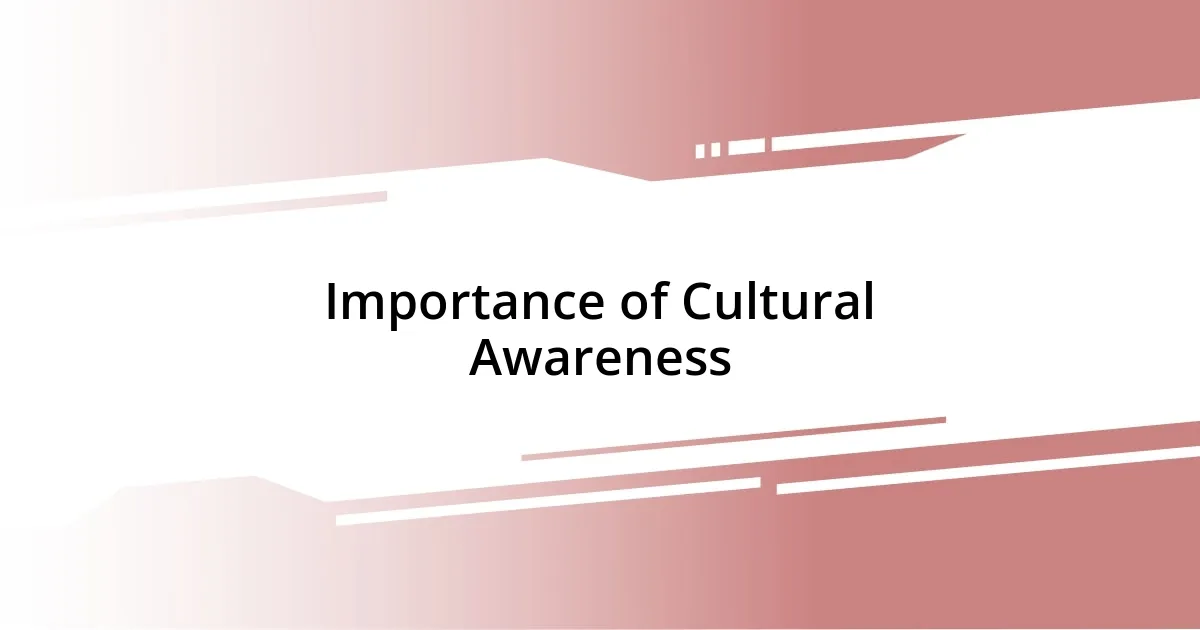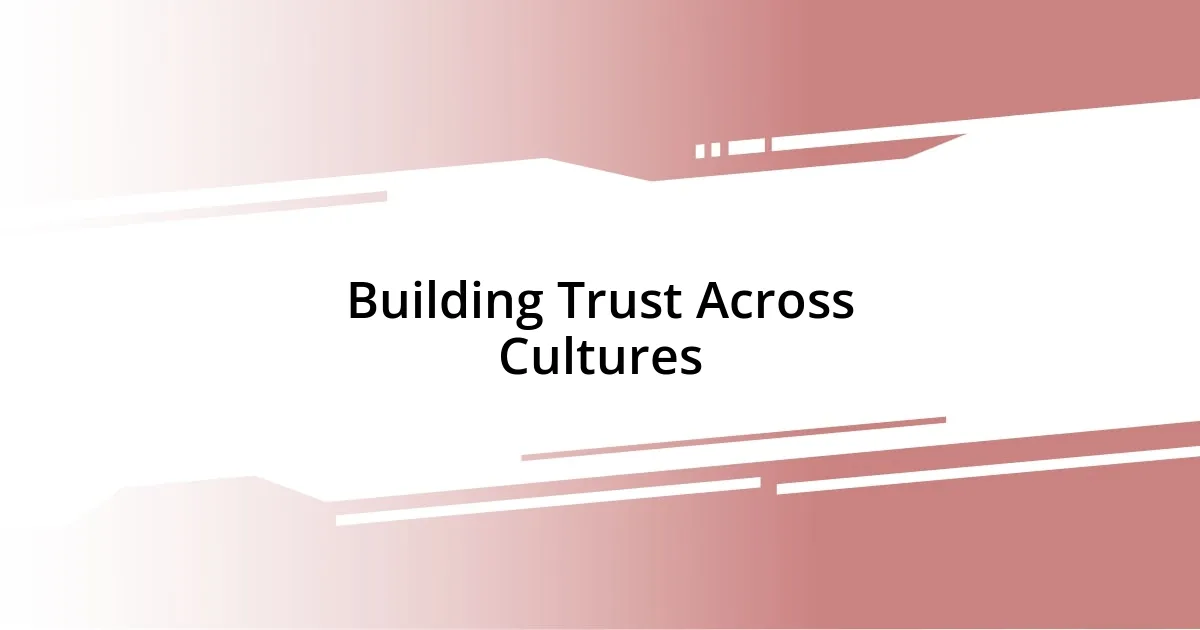Key takeaways:
- Understanding cultural context is crucial to prevent miscommunication and foster collaboration.
- Active listening and empathy are key strategies for enhancing cross-cultural interactions.
- Flexibility in communication styles can lead to more meaningful connections and effective teamwork.
- Humor can bridge cultural gaps and create a shared sense of understanding among diverse groups.

Understanding Cross-Cultural Communication
Understanding cross-cultural communication is more than just exchanging words; it’s about grasping the underlying meanings that different cultures attach to those words. I remember a time when I misinterpreted a simple nod in a meeting, thinking it signaled agreement, only to find out later it indicated understanding rather than approval. How often do we make such assumptions in our interactions?
When I think of cross-cultural communication, I’m consistently reminded of the importance of context. During a business trip abroad, I discovered that a direct approach in the U.S. was seen as overly aggressive in Japan. Isn’t it fascinating how a simple shift in perspective can lead to vastly different interpretations?
Emotional nuances also play a critical role. I’ve felt the warmth of a smile cross cultural lines, yet I’ve seen how a frown can carry different weight depending on the culture. It leaves me wondering: how can we better train ourselves to recognize these nuances for more genuine connections?

Importance of Cultural Awareness
Cultural awareness is paramount in today’s interconnected world. I recall attending a workshop that brought together professionals from diverse backgrounds. The facilitator emphasized how cultural misunderstandings could derail projects or even damage relationships. That realization hit home for me; I learned that taking the time to understand cultural contexts can prevent miscommunications and foster collaboration.
Moreover, understanding cultural nuances can bridge gaps and create stronger connections. Once, while volunteering at an international event, I witnessed how greeting styles varied drastically among attendees. Some preferred a firm handshake, while others leaned towards a light bow. I learned that adapting to these differences not only shows respect but also builds trust, which is essential in any relationship, personal or professional.
Finally, cultural awareness goes beyond mere tolerance; it encourages appreciation for diversity. I remember a dinner with a multicultural group where each person shared a dish from their homeland. The conversations flowed, and I felt a deep sense of connection with everyone in attendance. Those moments of shared culture revealed not just our differences but the incredible richness each background brought to the table. Wouldn’t you agree that embracing cultural diversity can significantly enrich our lives?
| Aspect | Importance |
|---|---|
| Context Understanding | Prevents miscommunication in cross-cultural interactions |
| Building Trust | Adapting greeting styles fosters respect and stronger relationships |
| Diversity Appreciation | Encourages connection and enriches personal and professional experiences |

Common Challenges in Communication
Misunderstandings often emerge because we bring our own cultural lens to interactions. For instance, I once participated in a negotiation in a culturally diverse setting, and I spoke very directly because that was my norm. To my surprise, several participants seemed taken aback by my straightforwardness, interpreting it as a lack of politeness. It made me realize how vital it is to be adaptable, recognizing not just our intentions but how they might be perceived by others.
Here are some common challenges that arise in cross-cultural communication:
- Language Barriers: Even when conversing in a common language, nuances or idioms can cause confusion.
- Nonverbal Misinterpretations: Gestures or expressions may hold different meanings, leading to unintended offense.
- Contextual Differences: The same words may convey different messages based on cultural backgrounds and contexts.
I learned that being aware of these challenges not only fosters smoother interactions but also nurtures mutual respect. Engaging with others becomes an opportunity to uncover and appreciate diverse perspectives.

Strategies for Effective Communication
Understanding and adapting to different communication styles can significantly enhance interactions across cultures. I’ve experienced firsthand how using open-ended questions invites deeper dialogue. While attending a multicultural conference, I noticed that some participants appreciated a more relaxed conversation format. By shifting away from yes-or-no questions, I created a space for others to share their thoughts and experiences. This simple strategy not only enriched our discussions but also deepened my connections with attendees.
Another crucial strategy is active listening. One time, during a team project involving members from various regions, I made a concerted effort to truly hear what everyone was saying. I nodded, paraphrased their points, and asked clarifying questions. This approach helped me understand their viewpoints more profoundly and demonstrated my respect for their input. Have you ever had a moment when a small act of listening made a substantial difference in how you felt about a conversation? For me, it transformed the team dynamics entirely, fostering a sense of belonging.
Lastly, I’ve learned the power of empathy in bridging cultural divides. A close friend of mine from a different background shared a story that highlighted their cultural struggles. I remember feeling a mix of emotions—sadness for their challenges but also gratitude for their openness. It reminded me that showing genuine empathy can encourage others to express their feelings and perspectives without fear of judgment. Wouldn’t it be fascinating if more of us committed to understanding each other on a deeper level? This approach not only enhances our communication but also promotes a culture of acceptance and mutual respect.

Building Trust Across Cultures
Building trust across cultures requires intentional effort and genuine engagement. I remember sitting down for a meal with colleagues from various backgrounds, united by a shared project. As we discussed flavors and cooking techniques, laughter broke down barriers. It struck me that sharing food was more than just a meal; it forged connections. Could something as simple as a meal create such powerful links?
In another instance, I found that finding common ground can significantly enhance trust. During a cross-cultural workshop, I learned about the shared values of respect and ambition in different cultures. By actively acknowledging these commonalities, I could shift the focus from our differences to our shared goals. This realization wasn’t just enlightening; it created an environment where everyone felt valued. Have you ever noticed how recognizing shared experiences makes you feel more at ease with those around you?
Finally, consistency plays a crucial role in building trust. When I relocated for work, I met a colleague who consistently checked in on me, making sure I felt included. This small act left a lasting impression and set a foundation of trust in our collaboration. It reminded me that trust grows from reliability and empathy. Isn’t it fascinating how a few thoughtful gestures can lead to deeper, more meaningful connections across cultures?

Personal Experiences and Insights
I’ve often found that humor can be a wonderful bridge in cross-cultural communication. For instance, during a global team-building retreat, I made a light-hearted joke about my struggle with the local cuisine. To my surprise, several colleagues chimed in with their own culinary mishaps from different countries. It was a shared laugh that not only eased the tension but also revealed our universal experiences. How often do you think laughter can pave the way for friendship and understanding?
Another memorable moment was when I had the opportunity to give a presentation to an audience with diverse cultural backgrounds. I integrated cultural references that resonated with various groups. To my delight, the smiles and nods affirmed that my efforts were appreciated. This experience reinforced how crucial it is to adapt our messages to connect with others genuinely. Have you ever adjusted your communication style to foster better connections? It’s rewarding, isn’t it?
Lastly, I’ve experienced the impact of patience when engaging with different communication styles. During a collaborative project, a team member struggled to articulate their ideas due to language barriers. Instead of rushing the conversation, I consciously took pauses, allowing them the time they needed. That decision opened up a flow of ideas that revealed incredible insights. It reminded me that patience is not just a virtue; it’s a powerful tool in cross-cultural dialogues. Don’t you think fostering that space for others can unlock amazing conversations?

Key Takeaways for Future Interactions
In my experience, active listening is one of the most underrated skills in cross-cultural interactions. During a virtual meeting with international team members, I noticed that some participants would take time to gather their thoughts before responding. At first, I misinterpreted this as hesitation, but I soon realized it was a sign of deep consideration. Have you ever felt the need to truly listen before replying? It made me appreciate the richness that comes from different communication styles and the importance of creating space for everyone to contribute.
Another key takeaway I’ve found is the power of body language. I recall attending a cultural exchange event where gestures varied significantly among participants. While nodding is a sign of agreement in some cultures, it can mean something entirely different elsewhere. This led me to become more mindful of my own non-verbal cues. Have you ever caught yourself misreading someone’s body language? A simple understanding of these nuances transformed our dialogues into more authentic exchanges, fostering a sense of respect and awareness.
Finally, I believe flexibility is essential for successful cross-cultural communication. I once participated in a cross-functional project where team members had different approaches to timelines and deadlines. Initially, I felt frustrated, thinking my way was the most efficient. However, I learned to adapt and appreciate diverse perspectives—this adjustment not only improved our workflow but also strengthened our relationships. Isn’t it interesting how embracing flexibility can lead to richer collaboration? It’s a reminder that adapting our expectations can unveil new pathways to connect with others.














